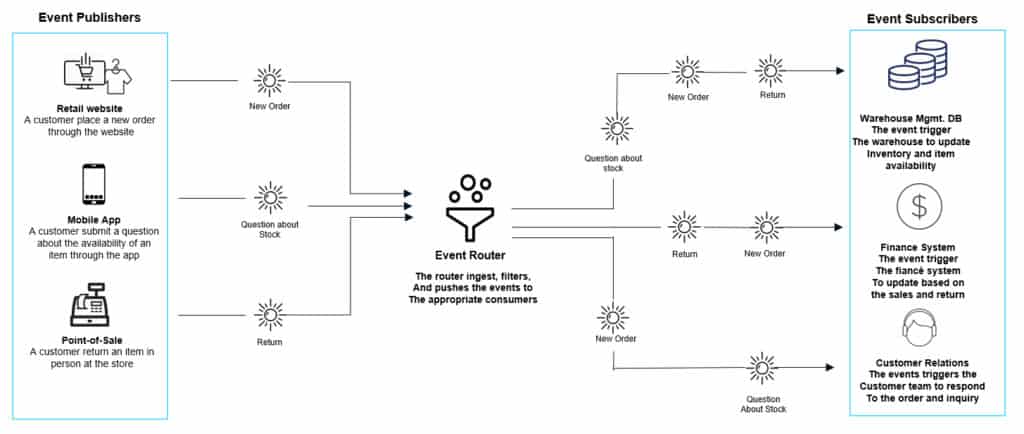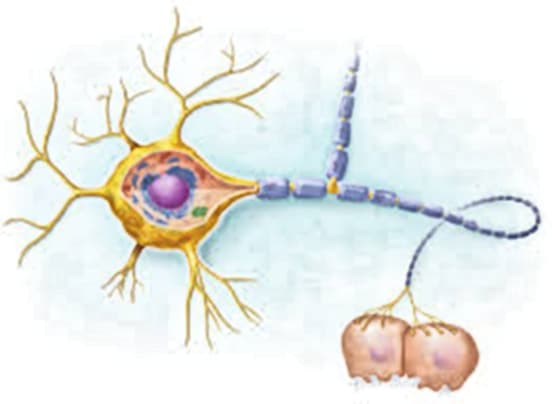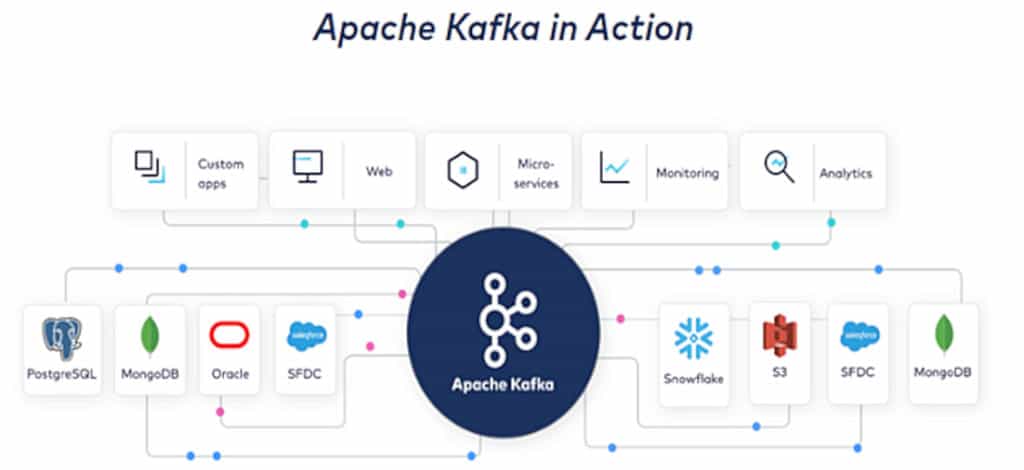
It’s Saturday morning in a typical suburban neighborhood when Marty’s new washing machine alerts her that her clothes are not fully dried, and her app, which claims to balance a myriad of daily tasks (events) using a simple smartphone, recommends cleaning her house exhaust system. Marty acts by cleaning it. The washing machine chimes in, she resubmits the semi wet clothes one more time, and they now are fully dried! It “knows” from key energy metrics and past cycle washing patterns what to do, all thanks to an event-driven architecture (EDA).
In the realm of the business world, “business events” can be represented digitally, reflecting the discovery of notable states or changes in state, in the form of a completed purchase order, a notification for benefits open enrollment, or an item being placed in a shopping cart on an e-commerce website. These are examples of digitally reported events. Many business events, or convergence of events, form business moments, detected situations that call for consumer or business action.
How it works: Example EDA Architecture

Sense and respond to business events
Today, business moments are the key building blocks that drive billions of internet of things (IoT) signals to become connected to the Internet and to each other. Businesses, however, will need to collapse traditional barriers between industry segments and outside company walls to exploit these connections and create new digital value chains. Critical yet transient business moments can be dynamically captured through the interconnection of IoT and enabled with Event Data Streaming architectures and capabilities.
Companies can leverage these moments to help expose new relationships, refine existing ones, and identify opportunities for the business. Event-driven platforms that usher cultural and operational changes are at the heart of a well-run digital business. In most of these companies, event streaming was initially adopted to enable a single, scalable, real-time application or data pipeline for one particular use case. This initial usage tends to spread rapidly within an organization to other applications and its use cases like a virus disseminated within a host.
Prepare for new thinking and cultural change

You’ll know your organization is evolving to event thinking when your strategic reasoning is no longer supported by just individual monolithic data-centric platforms, but also includes the live dynamics of business events and business moments circulating across your business and its ecosystem. The more significant business moments are those that have deep implications for multiple parties – across applications and lines of business. The more parties that are affected by a business moment, the greater its impact…the more context data and different types of events that are considered, the more nuanced the detection…the more engagement from advanced technology practitioners to support the business, the further the organization’s progress toward digital transformation…and, ultimately, the greater the competitive advantage and operational effectiveness.
Build a Dynamic Business

Event thinking envisions a dynamic business that is continuously adapting and innovating, where the IT network performs a role similar to a human nervous system, always thinking, always sensing, always learning and always ready. This is in stark contrast to traditional thinking which struggles to combine the long-standing model of application “stovepipes” to the agility and scale required for digital business. Few will undertake such a radical change in thinking just to improve their software architecture. However, given the extent of current and continuing business innovation, few will be able to avoid it. Welcome to the Modern Streaming Architecture!
Transform your business with real time data

Most organizations are facing an explosion of data. The ideal architecture is a clean, optimized system that allows businesses to capitalize on all that data. It’s time to build smarter, faster, more efficient businesses that are capable of handling real-time data, where the faster you can get a piece of data and respond to it, the more valuable it is.
Today, over 75% of the Fortune 100 are redefining the business landscape through event streaming technology. For example, financial services organizations around the world that capitalize on these streams of data are creating a new, powerful customer experience, seamlessly designed for regulatory uncertainty, and lowering risk in real-time while driving growth and powerful new use cases. Like a digital central nervous system, an event streaming platform connects all your applications and systems, distributing data to every corner of your organization. Kafka is used everywhere across industries for event streaming, data processing, data integration, and building business applications / microservices. It is deployed successfully in mission-critical deployments at scale at tech giants, startups, and traditional enterprises. Scenarios include cloud, multi-cloud, hybrid, and edge infrastructures. Among the most important use cases are:
- Customer 360
- Real-time fraud detection
- Mainframe offloading and IT modernization
- Log Aggregation
- Operational Metrics/KPIs
Conclusion
Event streaming platforms such as Confluent Kafka can act as a central nervous system by transmitting signals (events) between producers and consumers, and the rest of the downstream systems of record. The focal point of event streaming is, unsurprisingly, an event stream. At minimum, an event stream is a durable, totally-ordered, unbounded sequence of immutable event records, delivered at least once to its subscriber(s). An event streaming platform is a concrete technology that implements the event streaming model.
We can think of individual, disconnected UI-centric applications as a kind of single-celled organism of the software world. One doesn’t get to an integrated digital company by simply stacking many of these applications on top of one another, any more than a dog could be created from a pile of undifferentiated amoebas. A multi-cell animal has a nervous system that coordinates all the individual cells into a single entity that can respond, plan, and act instantaneously to whatever it experiences in any of its constituent parts. A digital company needs a software equivalent to this nervous system that connects all its systems, applications, and processes. This is what makes an emerging event streaming platform the single most strategic data platform in a modern company.
For more information on our consulting services contact us at Info@ctidata.com.